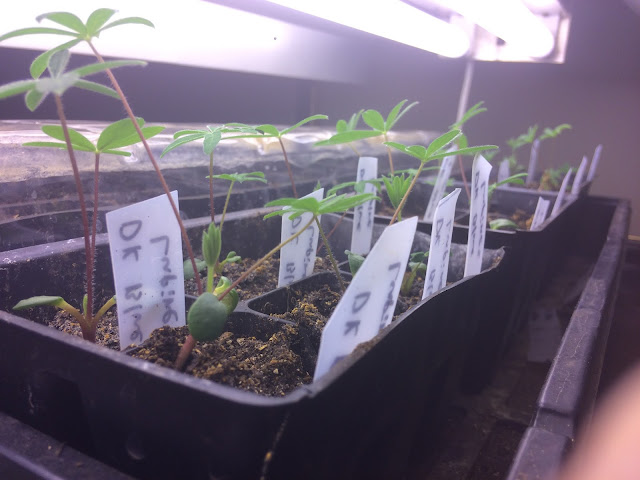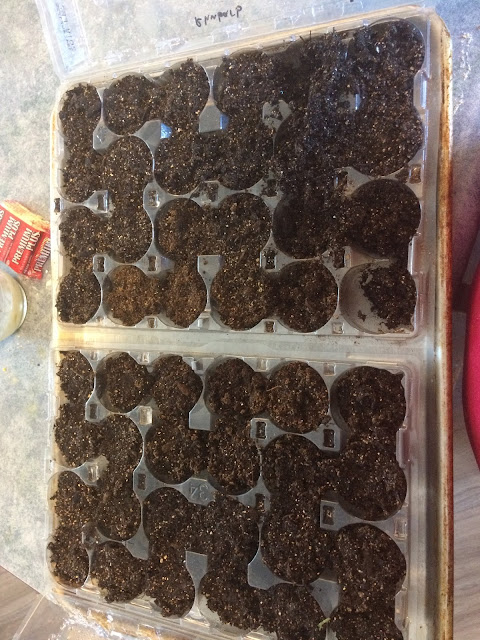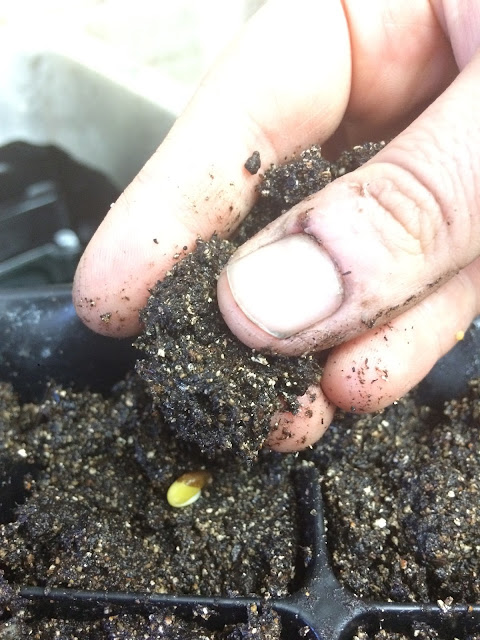Stuff is growing decently! I've had not-amazing luck with seed germination rates this year... And I'm attributing that to my own adjustment from being a window gardener to a grow-light gardener... Some seeds got too much heat from the wrong kind of bulb I think, and some may have been too cold in the basement, and some maybe too wet, cause the water didn't evaporate as I expected it to... All in all, a few plants from most kinds of seeds though!
HOLLYHOCKS!
I haven't had very much luck with my hollyhocks... I'm pretty bummed about that, but c'est la vie! And live'n'learn!
 |
| Black hollyhock seeds: only 7 out of 48 seeds sprouted. |
 |
| multi-color mixed hollyhocks: only 4 out of 48 seeds sprouted... :( |
I e-mailed the seed provider from amazon about several varieties that didn't seem to germinate well, and she had some tips. Specifically hollyhocks can be soaked and even scarred but she said that stratification may have significantly lowered germination rates... and I'd say she's right! :( the research was so mixed on whether to do it or not, but oh well! Live and learn! I may buy some more seeds yet.
 |
| Transplanting black hollyhocks: I used the end of a paint brush to delicately lift them out of the loose soil. |
 |
| they transplanted very well. |
I also talked to the Nikovita seed lady about my Delphiniums which aren't doing much at all... Sadly, she informed me that they need to have no light exposure! bah!! see? Even the greenest of thumbs, only gets good at gardening, by making mistakes along the way! So These seeds haven't done well being placed on top of the soil, and then under a grow light! lol! I guess they do well at my parents cabin because the seeds fall on the soil and then get covered by autumn leaves so they are both shaded, but on top of the soil... If Nikovita still has some in stock, I may try growing these again.
 |
| probably almost a hundred seeds in this container of delphiniums... and only five sprouts. I will let them get bigger before transplanting. |
LUPINES!
These things are doing awesome! And Nikovita confirmed that these were sewn properly. scarification, stratification and then sewed under a cooler grow light (not one that emits heat)
So hey! At least I'll have some pretty Lupines this year LOL!
TOBACCO!
Tobacco has been very slow growing, so I'm glad I started it as early as I did!
 |
| 2 weeks of post-germination growth. very small. |
I have had some "damping off" happening with the second round of tobacco sprouts I transplanted... With most of my seeds, the initial quicker sprouts have proved to be the strongest plants with the most vitality. Damping off has to do with either too-moist of soil, or with mold growth in the soil that rots the stem right at soil level, killing the plant. I still have several tobacco plants left though, so I'm not too worried about the ones that dampened off.
I haven't noticed any particular tobacco-like smell to them at all yet, but they are only just working on their first sets of true leaves.
SNAP DRAGONS!
I did re-seed my snapdragons last week, because I did them too thick to transplant last time!! this time i sewed them much more sparsely, and they have done very well. Again almost 100% germination rate. And this time it should be easier for me to divide these and transplant them better.
As I suspected, about 80% of the previously transplanted snappers have died off. but there's a few resilient strong ones sticking around. And those are exactly the kind of snap dragons I'd like to grow and save seed from anyways. A little survival of the fittest--when seeds aren't in short supply-- is just fine with me!
FORGET-ME-KNOT AND HYSSOP:
Ah yes, most of us bible-thumpers right away think of "cleanse me with hyssop"... :) Hyssop is in the mint family and is an awesome herb! I don't know why it's not more popular! My plan is to interspurse it in my garden with other plants, so it can keep away bugs and pests. It's touted as being good for repelling cabbage worms too!
 |
| left, thicker plants are hyssop. Right smaller ones are forget-me-knots. |
I have been very impressed with the germination of my hyssop seeds! These are from Heritage Harvest Seeds, a company I highly recommend for seed purchasing (no, I'm not sponsored. This is a genuine recommendation with zero pay-out to myself).
My forget-me-knot seeds have also had an almost 100% germination rate! These I seed-saved last summer as well. My seed-saving has been paying off big-time this year. So far, they have all worked flawlessly. with flower seeds, the trick is to let the flower fully die on the plant, so the seeds can mature properly. But still watch it carefully enough to harvest the seeds before they fall off naturally and disappear.
PEPPERS!
Peppers have been doing pretty good! Again, germination rates weren't amazing, but I really think this was because of my hotter grow light making it an unpleasant environment for the seeds to grow. I've just unscrewed those bulbs from a few spots... I'm not happy with them. I'll be sticking to the cooler tube lights in future.
The first stronger sprouts are already working on their second set of true leaves, while the later sprouts are quite a bit smaller, and working on their first set of true leaves.
GROUND CHERRIES
The ground cherries and the Tobacco are growing at roughly the same rate. Actually the ground cherry is almost a bit quicker! Ground cherries grow very slowly. By the end of the entire summer, my ground cherries were still very small plants... So I'm hoping I'll have a head start on them this year! In my later sprouted seeds, I had several that just died for no apparent reason. They didnt rot on the stem, the leaves just withered and it died. But my ground cherry seeds were seed-saved. So perhaps not all the seeds were mature enough to grow a true plant, is all I can think of. I still got some plants though! :) Last year I only had one plant. So i'm already ahead that way. Again, like the others, my initial sprouts are doing stronger and better than the second round of transplants, which are getting some damping off die out.
RHUBARB!
Well, i'm down to only ONE Ukraine rhubarb plant... but if you've ever had rhubarb grow in your yard, you know that one is plenty! :) So i'm still optimistic I can keep this thing alive! lol! I have several manitoba ones, but they don't look as big or vibrant just yet!
 |
| large round leaf is on the Ukraine rhubarb plant. Mb rhubarb much smaller, and struggling, but alive. |
NEEDING MORE LIGHT SPACE!!
Well, thats all the updates for today! In the next couple of days, i'll be transplanting the forget-me-knots, the hyssop, and the snap dragons. By then I'll have a full over-flow on my plant table. But luckily for me, plants only need 12 hours of sunlight! I can actually run two full sets of plants on the plant light, by giving the trays a day or night shift of 12 hours.
So my less important plants (AKA flowers) will be on a reverse sunlight schedule, and get darkness during the day, and plant lights at night, after the transplantation occurs. I'll somehow revert them back when i'm able to move everything outdoors.
The reason I say my "lesser" plants, is because I'm a strong believer in the moon's affect on a plant! I have no idea what it actually does, and this is not scientific, simply my own nature-loving-folkways I'm creating... but if the moon DOES play a role, I don't want to mess up my veggie plants by not allowing them a proper night time, at night with the moon's gravitational pull and whatnot. (feel free to think I sound crazy! haha!). Flowers are just flowers. They generally don't have as much of a life cycle like veggies do (other than perennials). They flower till they die from frost. So that being the case, I care less if their biological clocks get messed up by being on the night shift.
Anyways! Thats it for now!
Until next time, KEEP IT GREEN! :)



























































